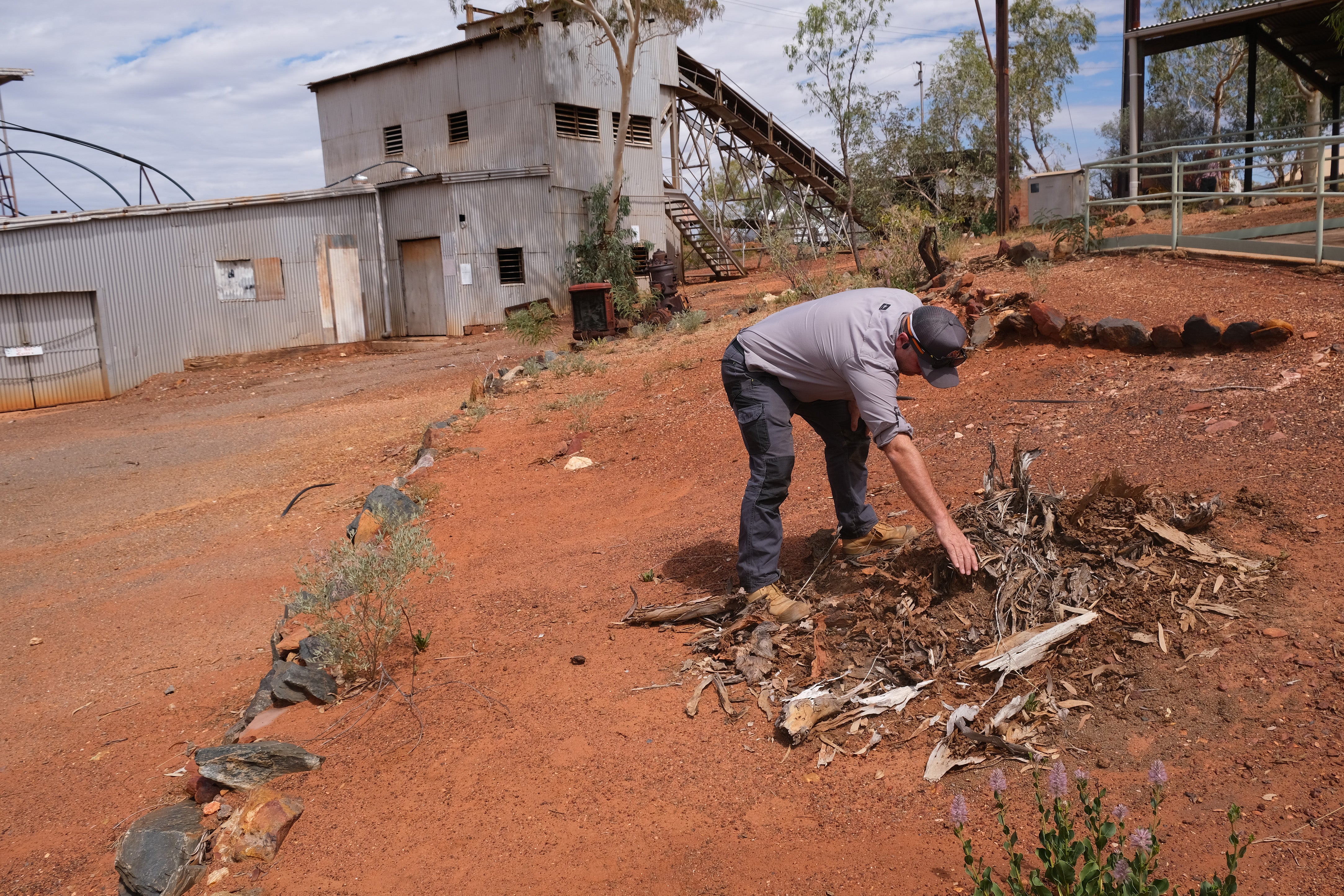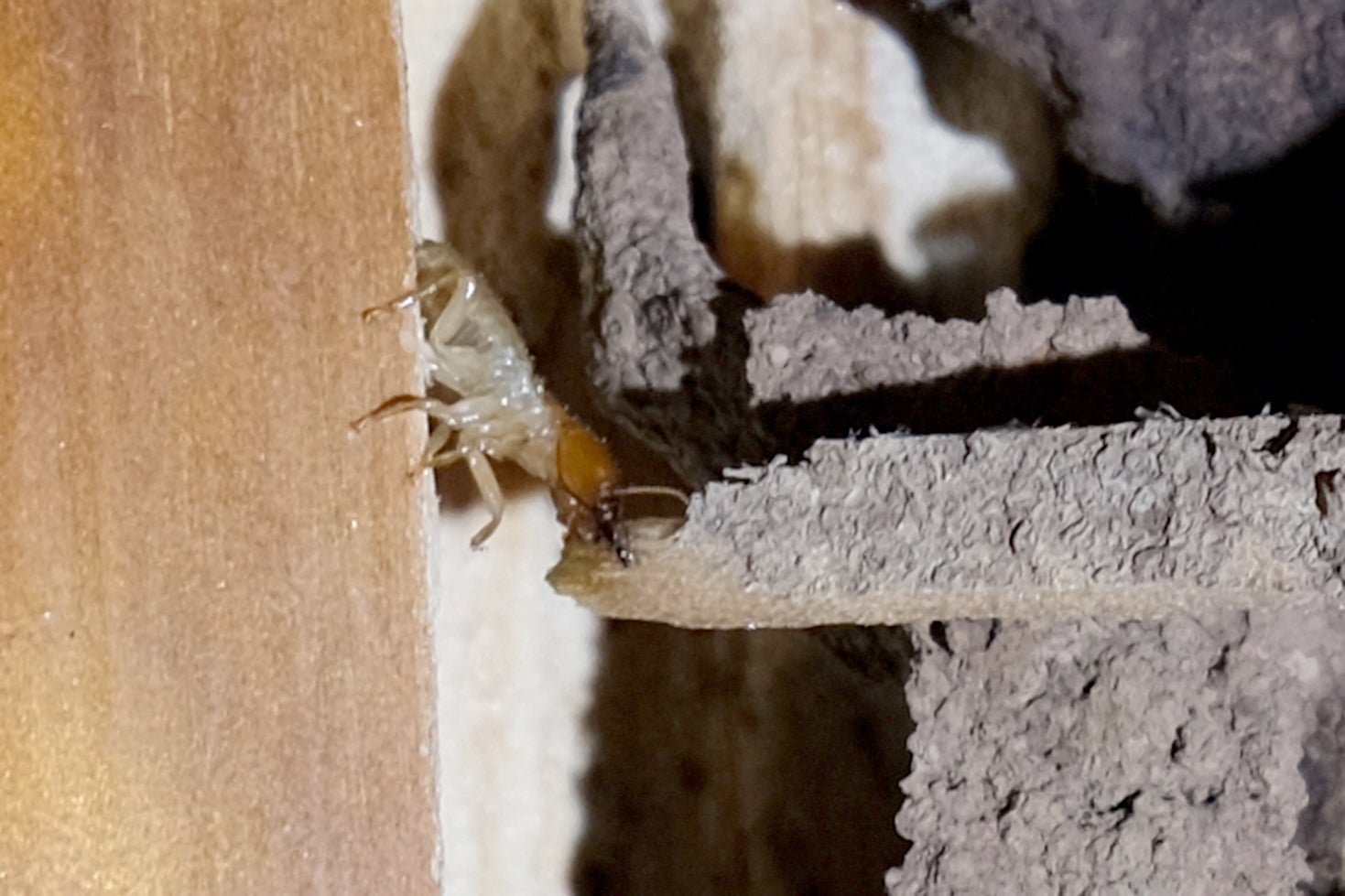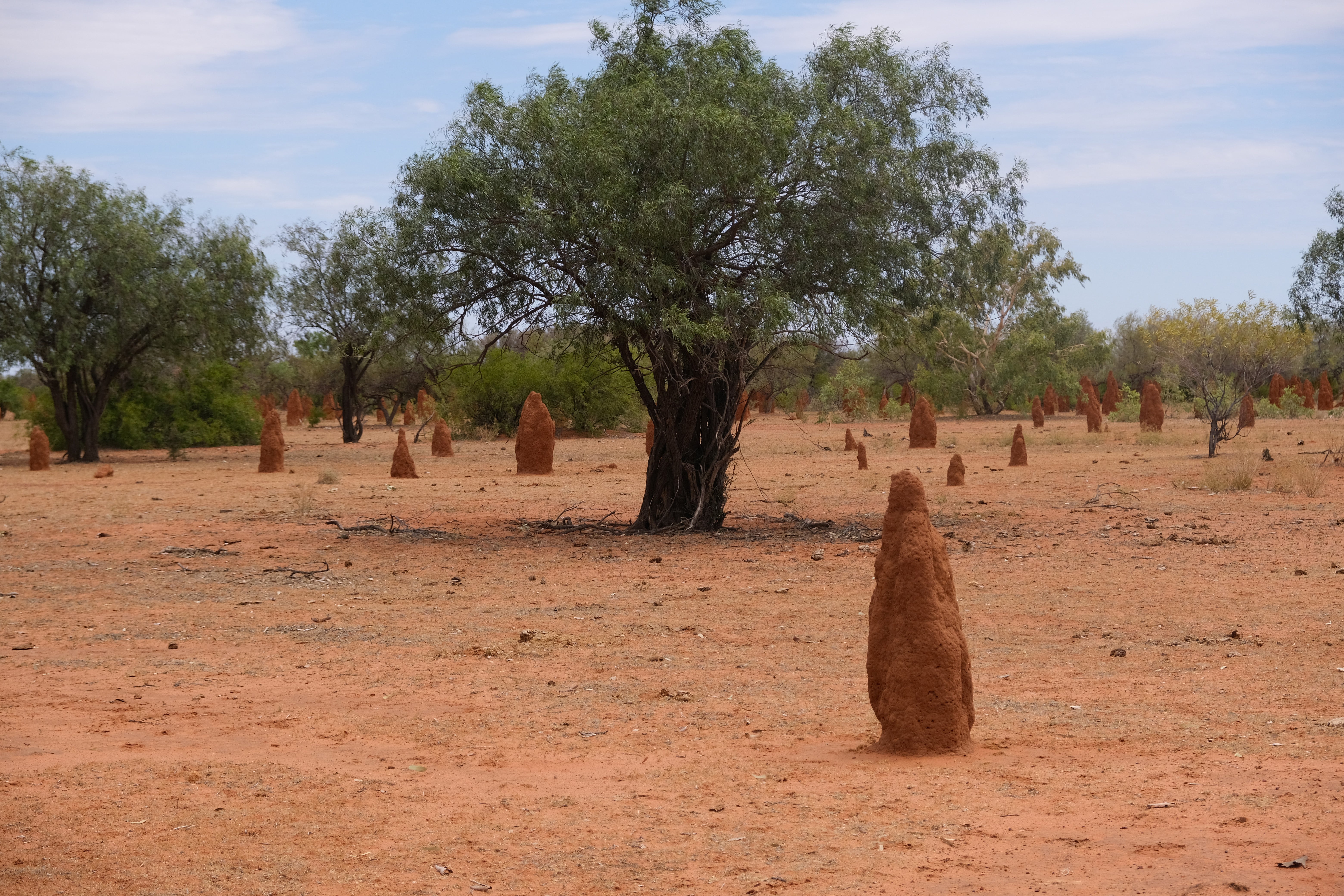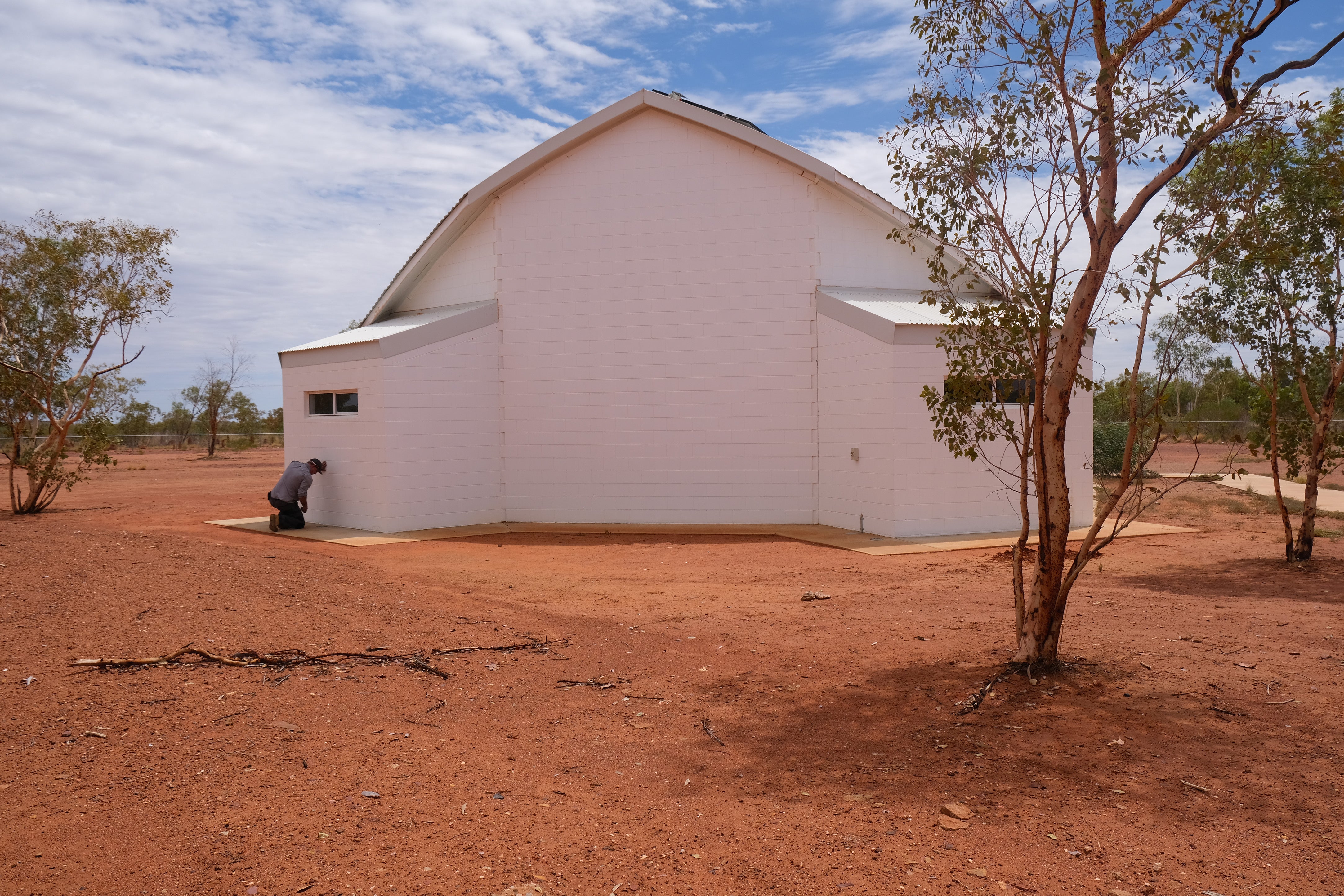
In a forgotten restaurant behind a gas station in Australia’s red centre, only metal and plastic parts remain unscathed. Chris Cook grabs at a timber door frame, which crumples like paper in his hand.
“This has all just collapsed,” says Cook, a manager at Territory Pest Control in Australia’s Northern Territory. He eyes boards hanging in ragged pieces from the ceiling. Since he last visited the abandoned building three years ago, thousands of uninvited guests have been busy.
The destruction at Galaxy Auditorium restaurant at Wycliffe Well – a tiny highway stop which calls itself the “UFO capital of Australia” – is the destruction that could lie ahead for many places on the continent unless mastotermes darwiniensis can be stopped. These termites are the last survivors of an ancestral species that shared space with dinosaurs 150 million years ago. They’re voracious and relentless. And because of climate change, they, like their fellow kin, are expanding their range.
A study conducted on six continents and published in Science last spring revealed just how much termites love a warming planet.
“The extreme response was really surprising,” says Amy Zanne, a professor in tropical ecology at the University of Miami and the study’s lead author. She corralled more than 100 scientists to place blocks of wood at 133 sites around the world and then to measure the speed at which they were eaten in different climates. “We ran the numbers again and again,” she says.
Termites are crazy about heat, the study confirmed and quantified. For every 6C increase in temperature, their “wood discovery and consumption” increased almost sevenfold.
The Australian species is the most primitive of all termites, the closest to the root of the evolutionary tree. Also called “mastos” or giant northern termites, they have a breeding superpower: almost any member of a colony can transform itself into the breeding queen if the previous monarch is felled. Not only that, they have a broad palate and have been known to eat lead, plastic, leather, ivory and asphalt. Cook once treated a colony that took to a concrete building’s water pipes and climbed eight stories.
The species has long been an infuriating part of life in the tropical north of Australia, the only place it once was found. But over the past two decades, it has started establishing itself farther south.
Cook spends his days driving thousands of miles across the often scorching Northern Territory. Tennant Creek – more than 10 hours from Darwin, the territory’s capital and the closest city – is the small community where he’s testing whether the termites can be blocked or at least contained with bait. The greatest worry is the impact they could have on the main town in Australia’s huge and isolated Outback: Alice Springs, population 25,000, directly in the line of their apparent advance.

“It’s a matter of when, not if,” Cook says of the prospect. “They’re going to get here, and when they get here they’re going to cause a lot of problems.”
Theo Evans, a biologist at the University of Western Australia who specialises in termites, says the giant northern termite first appeared about 20 years ago in the town of Ti Tree, 800 miles south of Darwin. It’s now a common pest there, chomping through structures and hollowing out the local palm trees, a particularly favourite meal.
Yet the pest control business has already treated damage several hours to the south, including in the remote Indigenous community of Papunya, which discovered its school under attack.
Temperature extremes are what have protected arid parts of Australia to date. In the country’s tropical zones, where the weather is reliably balmy, the giant northern’s gluttonous garrisons are plentiful. Like reptiles, the termites do not generate their own body heat but absorb it from the environment. Even in the tropics, when the temperature drops below 20C, “these termites can barely walk,” Evans says. “It’s quite funny to see.”

Frosty winter nights in Alice Springs are decreasing, though. Mean temperatures have increased by about 0.5C since 1910, and the number of days above 40C annually has doubled since 1950.
Cook roamed Tennant Creek, checking a group of buildings that make up a tourist attraction touting the region’s gold mining past. He later would place the bait stations intended to attract termites, each containing a new pesticide intended to kill the insects after they inadvertently transport it back to their colonies.
No bait so far has proved effective against mastos. “If this product works ... we’ll be ready for when they hit Alice Springs,” he says.
Australia is far from the only place where worsening termite woes – and their extraordinary cost – seem likely as the world grows hotter.

“People in Chicago, who have very few issues with termites – not zero, but very few – they might start getting the kinds of problems that people further south would have,” Evans says. “And people in Toronto who basically don’t have problems with termites at all, they might start getting the sorts of issues that Chicago has.”
Modelling in 2017 by Purdue University and the University of Lausanne concluded that 12 of the world’s 13 most invasive termite species could increase significantly in distribution by 2050 given Earth’s current temperature trajectories. The possible incursion zones extend from Canada to Patagonia, Finland to Iran, New Zealand to Namibia – and even to Greenland.
Meanwhile, two Floridian varieties have demonstrated another possible threat as species’ habitats begin to overlap: hybridisation into new “highly destructive super-termites.” Coptotermes formosanus and coptotermes gestroi have shown a tendency toward interbreeding in warm winters, University of Florida scientists discovered in 2015. The young grow twice as fast as their parents did.

Termites cause billions of dollars in damage globally each year. They also play an outsize role in the carbon cycle.
“Basically they’re like little cows, but rather than burping they’re farting out methane,” Zanne says. Both creatures’ guts have evolved to be the perfect home for microbes that break down cellulose, part of the plant cell wall, into nutrients and discard methane gas as waste in the digestive process. About 20 million tonnes of methane are released annually, into the ground or atmosphere, from the back end of termites.
Still, she adds, “if we didn’t have things like termites and microbes to decompose things, we’d be walking on a pile of dead animals and plants. But what happens when you perturb the system by doing things like warming the planet?”

Alex Cheesman, a soil scientist with James Cook University who contributed to the Science study, says an increase in termite populations could create a worrisome climate feedback loop.
“You get increased climate change as a result of the climate changes, and therefore it’s really problematic,” he says. The hotter the world becomes, the more termites may thrive. The more termites thrive, the more methane may be released into the atmosphere. The more methane, the hotter the climate becomes.
Driving the six hours from Tennant Creek back to his base in Alice Springs on a baking-hot December morning, Cook looked a tad sheepish in discussing how greenhouse gasses affect the pest control industry.
This year, for the first time in recorded history, southern Australia faced an outbreak of the deadly tropical illness Japanese encephalitis when mosquitoes proliferated after flooding that scientists say was exacerbated by warmer air. In the United States, Lyme disease continues to spread as the ticks that carry it move with warming temperatures into new areas. In the United Kingdom, destructive aphids are feeding on more plant species as the spring heat prompts them to lay eggs earlier.
“Climate change is really good for our industry,” says Cook, despite his personal worries about the planet. “There’s more cockroaches, more mice, more everything.”
© The Washington Post







